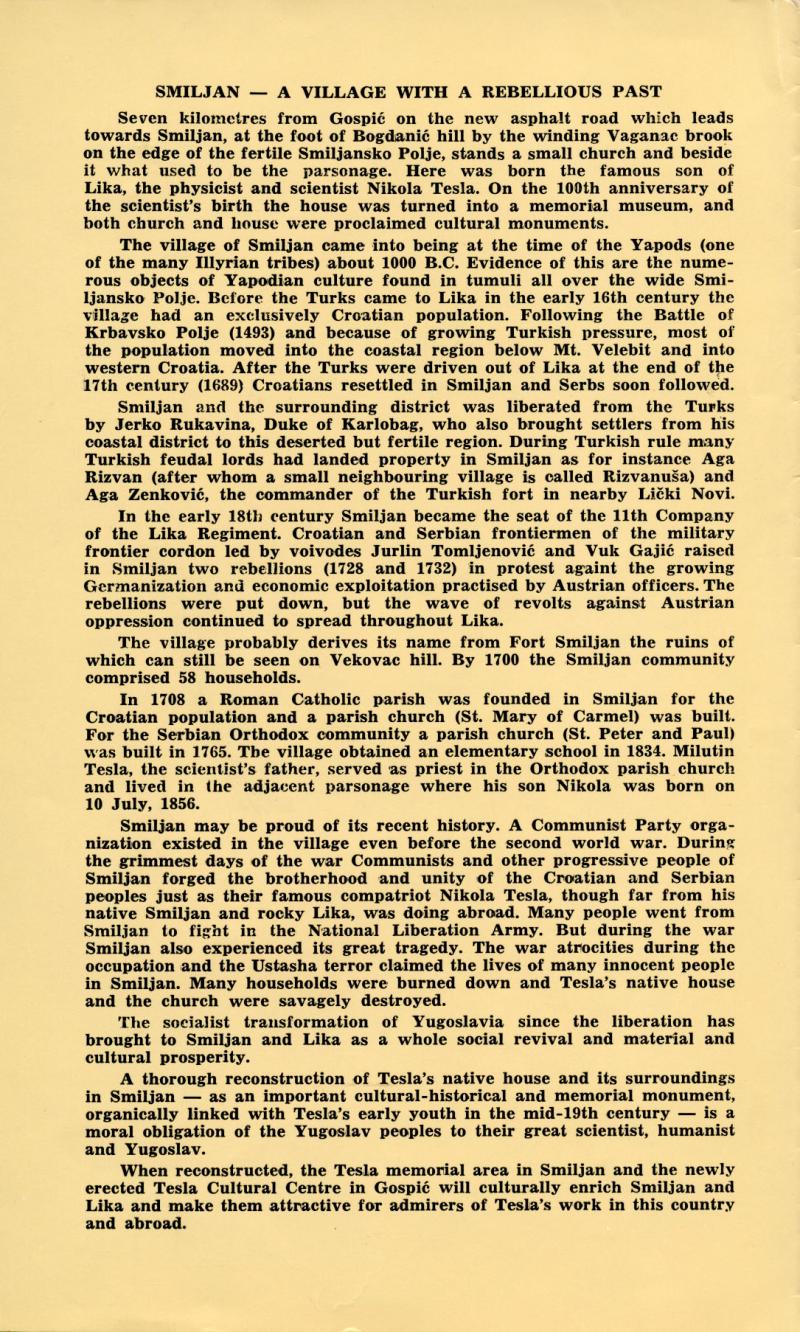
Nikola Tesla Books
Smiljan - A Village with a Rebellious Past
Seven kilometres from GospiÄ on the new asphalt road which leads towards Smiljan, at the foot of BogdaniÄ hill by the winding Vaganac brook on the edge of the fertile Smiljansko Polje, stands a small church and beside it what used to be the parsonage. Here was born the famous son of Lika, the physicist and scientist Nikola Tesla. On the 100th anniversary of the scientistâs birth the house was turned into a memorial museum, and both church and house were proclaimed cultural monuments.
The village of Smiljan came into being at the time of the Yapods (one of the many Illyrian tribes) about 1000 B.C. Evidence of this are the numerous objects of Yapodian culture found in tumuli all over the wide Smiljansko Polje. Before the Turks came to Lika in the early 16th century the village had an exclusively Croatian population. Following the Battle of Krbavsko Polje (1493) and because of growing Turkish pressure, most of the population moved into the coastal region below Mt. Velebit and into western Croatia. After the Turks were driven out of Lika at the end of the 17th century (1689) Croatians resettled in Smiljan and Serbs soon followed.
Smiljan and the surrounding district was liberated from the Turks by Jerko Rukavina, Duke of Karlobag, who also brought settlers from his coastal district to this deserted but fertile region. During Turkish rule many Turkish feudal lords had landed property in Smiljan as for instance Aga Rizvan (after whom a small neighbouring village is called RizvanuÅ¡a) and Aga ZenkoviÄ, the commander of the Turkish fort in nearby LiÄki Novi.
In the early 18th century Smiljan became the seat of the 11th Company of the Lika Regiment. Croatian and Serbian frontiermen of the military frontier cordon led by voivodes Jurlin TomljenoviÄ and Vuk GajiÄ raised in Smiljan two rebellions (1728 and 1732) in protest against the growing Germanization and economic exploitation practiced by Austrian officers. The rebellions were put down, but the wave of revolts against Austrian oppression continued to spread throughout Lika.
The village probably derives its name from Fort Smiljan the ruins of which can still be seen on Vekovac hill. By 1700 the Smiljan community comprised 58 households.
In 1708 a Roman Catholic parish was founded in Smiljan for the Croatian population and a parish church (St. Mary of Carmel) was built. For the Serbian Orthodox community a parish church (St. Peter and Paul) was built in 1765. The village obtained an elementary school in 1834. Milutin Tesla, the scientistâs father, served as priest in the Orthodox parish church and lived in the adjacent parsonage where his son Nikola was born on 10 July, 1856.
Smiljan may be proud of its recent history. A Communist Party organization existed in the village even before the second world war. During the grimmest days of the war Communists and other progressive people of Smiljan forged the brotherhood and unity of the Croatian and Serbian peoples just as their famous compatriot Nikola Tesla, though far from his native Smiljan and rocky Lika, was doing abroad. Many people went from Smiljan to fight in the National Liberation Army. But during the war Smiljan also experienced its great tragedy. The war atrocities during the occupation and the Ustasha terror claimed the lives of many innocent people in Smiljan. Many households were burned down and Teslaâs native house and the church were savagely destroyed.
The socialist transformation of Yugoslavia since the liberation has brought to Smiljan and Lika as a whole social revival and material and cultural prosperity.
A thorough reconstruction of Teslaâs native house and its surroundings in Smiljan - as an important cultural-historical and memorial monument, organically linked with Teslaâs early youth in the mid-19th century - is a moral obligation of the Yugoslav peoples to their great scientist, humanist and Yugoslav.
When reconstructed, the Tesla memorial area in Smiljan and the newly erected Tesla Cultural Centre in GospiÄ will culturally enrich Smiljan and Lika and make them attractive for admirers of Teslaâs work in this country and abroad.
